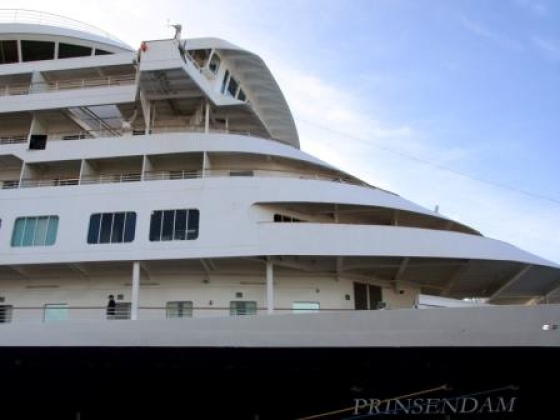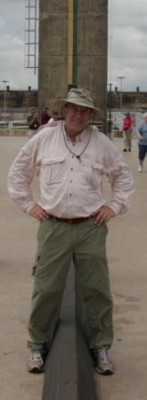Vanochtend om 5 uur werd ik wakker; ik vermoed dat een verandering van het wiegritme daarvan de oorzaak was. Het is vanzelfsprekend dat de prostaat er niet om treurde. We hadden inmiddels een kleine zijarm van de Amazone bereikt want we zouden aanmeren in Santana, een stadje 20km verder dan Macapà. Nu ja, stadje, het betekent wel 100000 inwoners.
Laat ik eerst iets over aardrijkskunde vertellen, dan is dat uit de weg. Macapà telt 500000 inwoners, ligt pal op de evenaar, en is de hoofdstad van Amapà, de meest Noordoostelijke staat van Brazilië. Volgens de gids ongeveer even groot als België en Nederland tezamen. Ik was wat verrast door die vergelijking. De Benelux wordt niet alle dagen als maatstaf voor uitgestrektheid gebruikt. Mijn verbazing kreeg een andere dimensie toen hij er laconiek aan toevoegde: “dus iets kleiner dan Frankrijk”.
Via Google Maps heb ik het op een 130000km² geschat. Daarvan is ongeveer 85000km² primair en ongerept oerwoud. Slechts 2% van het oerwoud is gerooid, een Braziliaans record. Autowegen zijn, buiten Macapà, onbestaande. Het gebied is trouwens zo geïsoleerd dat er geen Engelstalige gidsen zijn. Die komen van de dichtstbijzijnde stad, Belèm, aan de andere oever van de Amazonedelta, op 300km afstand. Praktisch gezien neemt de reis één dag boot in beslag, of 40 minuten vliegen.
Het klimaat is equatoriaal. De temperatuur varieert quasi altijd (impliceert eveneens dag en nacht) tussen 24°C en 36°C. Er zijn twee seizoenen: het regen- en het droge seizoen. In het eerste geval regent het altijd (dec – jun), in het laatste regent het elke dag, dixit Alvaro, onze gids. Het verschil zit hem in hevigheid en duur. Het droge seizoen kent hevige buien van 5 minuten, het natte langere perioden van dagelijkse regen.
Ik stel vast dat deze uitleg een groot stuk van mijn normaal dagelijks volume heeft ingenomen! Ad rem dan maar! Om 8 uur was alles in orde om van boord te gaan. We zouden de “Highlights van Macapà” bezoeken, t.t.z. het “Fortaleza de São José de Macapà”, de lokale Inheemse Ambachtelijke Boetiek, het openluchtmuseum Sacaca en de “Monumento Marco Zero”.
Over deze toeristische trekpleisters kan ik kort gaan: behalve in Sacaca viel er niet veel te rapen. Om eerlijk te zijn, in Sacaca hing het fruit ook wel aan de bomen, en dus evenmin te rapen. Plukken had de gids eveneens verboden. Wat ik er wel opgepikt heb is de enorme variëteit aan exotisch fruit dat hier groeit, en in Europa ongekend is.
“Aisa”, een zeer kleine zwarte bes met grote zaadjes en weinig vocht-per-bes, wordt momenteel gegeerd door de grote voedings- en farmaceutische industrie omdat het enorm veel anti-oxidanten bevat. Een toverdrank waaraan ze de levenslustige Westerlingen maar al te graag verslaafd zouden maken! Trouwens wordt de meeste bloem hier gemaakt van … maniok! Zoals de ouderen onder ons op school hebben geleerd, behoorde maniok ook tot het basisdieet van onze zwarte vriendjes in het verre Congo. Zo zie je maar dat alles altijd samenkomt – als er maar genoeg elementen zijn.
Welke lessen hebben we vandaag nog geleerd?
De eerste les was dat je hier niet snel een kiekje kan nemen, ik bedoel hier met het fototoestel, wel te verstaan. Mijn eerste foto van een Panamees schip dat houtsnippers aan het laden was, kwam er niet uit … aangedampte lens, en niet zo’n klein beetje! Hetzelfde euvel stelt zich ook met verrekijker en brillen. Als je uit een gekoelde plek naar buiten stapt, moet het glas “acclimatiseren”. In Amazonas duurt dat toch snel enkele ongeduldige minuten. Dat probleem zal zich, wat de bussen betreft, vanaf morgen niet meer stellen want stroomopwaarts is airconditioning in de lokale bussen of boten geen optie. Voor de fotograaf en de “verderkijker” is dat mooi meegenomen. Het toont nogmaals aan dat er aan elke medaille twee kanten blijven, ongeacht of je aan de evenaar dan wel aan de Zuidpool staat (ik hoop dit binnen exact één maand te kunnen herbevestigen).
Een tweede les had te maken met wateren, het werkwoord. Ervaringsdeskundigen stoppen niet met te benadrukken dat je veelvuldig moet drinken, liefst water. Welnu, er bestaat een techniek om ervoor te zorgen dat dit water niet snel daar loopt waar water altijd vanzelf naartoe loopt. (Voorde moeilijke verstaanders: naar beneden!) Tenslotte is het de bedoeling dat dit water het lichaam hydrateert, zonder direct de ingedommelde prostaat wakker te schudden! Hoe gaat dit in zijn werk? Je neemt een slok water en laat dit onder je tong glijden, waar je het wat heen en weer wiegt alvorens het door te slikken. Dus niet klokklokklokklok maar wel slok—slok—slok—… Ik heb het geprobeerd en ben met het resultaat niet ontevreden.
Een derde les betreft de taal. Uiteraard is een dag te kort om de indigene taal te leren. In deze staat, Amapà dus, kan je daar echter wel snelle vorderingen maken. Het viel me op dat alle inheemse woorden voor planten en dieren (dus niet Braziliaanse of Portugese termen) bestaan uit eenvoudige lettergrepen als daar zijn: ma, ca, pa, ba, sa, si, sai, bo, oia, po, ga, li, bi, waia, pi. Deze reeks is niet volledig maar snelle wiskunde leert me dat je daarmee al duizenden woorden van twee, drie of vier lettergrepen kan vormen die men in Amapà verstaat. Het enige probleem is dat je zelf wellicht niet hebt begrepen wat je gezegd hebt, en dat kan soms wel vervelend zijn.

Daarmee is het belangrijkste van vandaag verteld, op een paar mijmeringen na. De eerste betreft het feit dat ik blij was om nog eens wat straten te zien met wat vrouwelijk schoon. Niet verwonderlijk, hoop ik toch! De tweede is eigenlijk veel te complex om hier op een habbekrats uit de doeken te doen. Deze mijmering betreft een poëtische impressie in verband met het spanningsveld tussen de zee en de rivier, tussen de Atlantische Oceaan en de Amazone.
Zelf vind ik het ontroerend mooi maar heb momenteel geen calorieën op overschot. Ik kom er morgen zeker op terug, tenzij … de geplande Piranha Fishing erg zou tegenvallen, maar daarover maak ik me eigenlijk (vooralsnog) geen zorgen.
 Ach ja, ik stond ook op de “Marco Zero”: met één been in het noordelijk halfrond en één been in het zuidelijke. Het geeft een eigenaardig gevoel tussen de benen, moet ik toegeven. Terwijl we het bruine water stroomopwaarts doorklieven, wou ik nog even kwijt dat er dagelijks nog een andere congregatie op het schip vergaderd. Het zijn de “Friends of Bill W”. Als iemand weet wie dat mogen zijn, laat het mij weten! Ik ga alvast morgen mijn eigen licht opsteken!
Ach ja, ik stond ook op de “Marco Zero”: met één been in het noordelijk halfrond en één been in het zuidelijke. Het geeft een eigenaardig gevoel tussen de benen, moet ik toegeven. Terwijl we het bruine water stroomopwaarts doorklieven, wou ik nog even kwijt dat er dagelijks nog een andere congregatie op het schip vergaderd. Het zijn de “Friends of Bill W”. Als iemand weet wie dat mogen zijn, laat het mij weten! Ik ga alvast morgen mijn eigen licht opsteken!
Prinsendam, donderdag 13 januari 2011, 19u
Santarem, here we come!

 Ah, I almost forgot! I stood also across the Equator, “Marco Zero”: one leg in the southern hemisphere and one in the northern. I have to admit that it creates a somewhat strange feeling between the legs …
Ah, I almost forgot! I stood also across the Equator, “Marco Zero”: one leg in the southern hemisphere and one in the northern. I have to admit that it creates a somewhat strange feeling between the legs … 